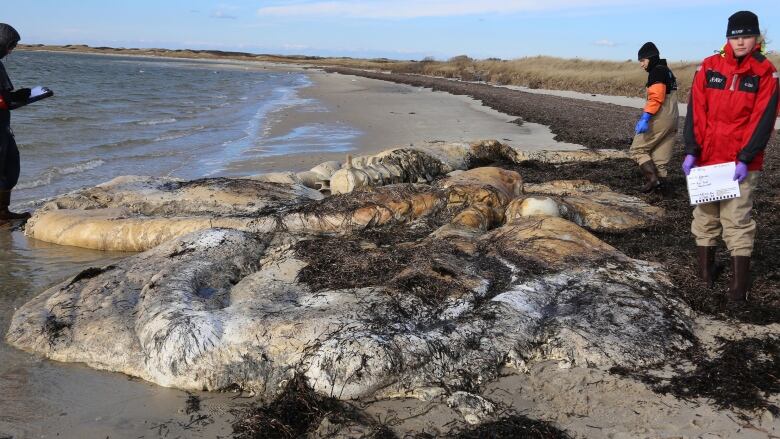'Deflated' carcass declared 17th North Atlantic right whale to die this year
Endangered right whale population has lost 4 per cent of its members in 2017

A badly decomposed carcass that washed up in Massachusetts is being counted as the 17thNorth Atlantic right whale to die during a brutal year for the endangered species.
OnNov. 27, the remains of a right whale were found on a beach on Nantucket, an island off Cape Cod.
Researchers wereinitiallyhesitant to addthe animal to this season'stally of dead right whales out of concernit had already been counted floating at sea in August.
They have since decided this whale will be considered "Whale 17."
"And trust me, no one would be more thrilled if we in factconfirmthat this is not a 17th carcass, that it is the same as the one that was seen in August," said HeatherPettis, anassociate scientistat the Anderson Cabot Center for Ocean Life atthe NewEnglandAquarium in Boston.
"I would love to be wrong."

Genetic testing will be used to determine withcertaintyif the classification is correct, but results could take months.
The carcass found on Nantucket was what scientists call deflated, because a whale's internal organs decompose at a much faster rate than its blubber exterior.
The mass of organic matter wasidentifiedas a North Atlantic right whale by itsdistinctiveflippers, whichdecomposeat a slower rate than the rest of thecarcass, said MariannaHagbloom, a research assistant with the Anderson Cabot Center.
"We try to be as conservative as possible when saying that a new carcass has beenidentified," Hagbloom said."Andso,weareannouncingthis assumption that we're making, but we wouldn't have done that lightly."
Cause of death unknown
Four per cent of the North Atlantic right whalepopulation died this year, a massive loss for a species that numbers fewer than450.
The researchers said they may never know how the 17th whale died, but some of theothers found this year were hit by ships or got entangled in fishing line.
Several factors were taken into account beforeadding the whale to the list of dead, includingidentifying physical features that were not seen onthe whale carcass spotted in August.
"There were someindentations that suggest scarring of some sort," Pettissaid."Scars are one thing of many that we usetoidentifyindividuals."
Awaiting genetic testing
An ocean driftanalysiswas also done onthe dead whale discovered at sea to project where the carcass would eventually wash up. While it is possible that whale could have drifted to Nantucket, theanalysis suggested otherwise, Pettis said.
"There is some evidence to suggest that this is a new whale," said Pettis, who is also the executive administratorwith the North Atlantic right whale consortium. "But we can'tconfirmthat until we have the genetics."
CBC New Brunswick produced a six-episode podcast on the deadly summer for North Atlantic Right Whales. You can find it atcbc.ca/podcasts, or search for"Deep Trouble" on iTunes.













_(720p).jpg)


 OFFICIAL HD MUSIC VIDEO.jpg)
.jpg)



























































































